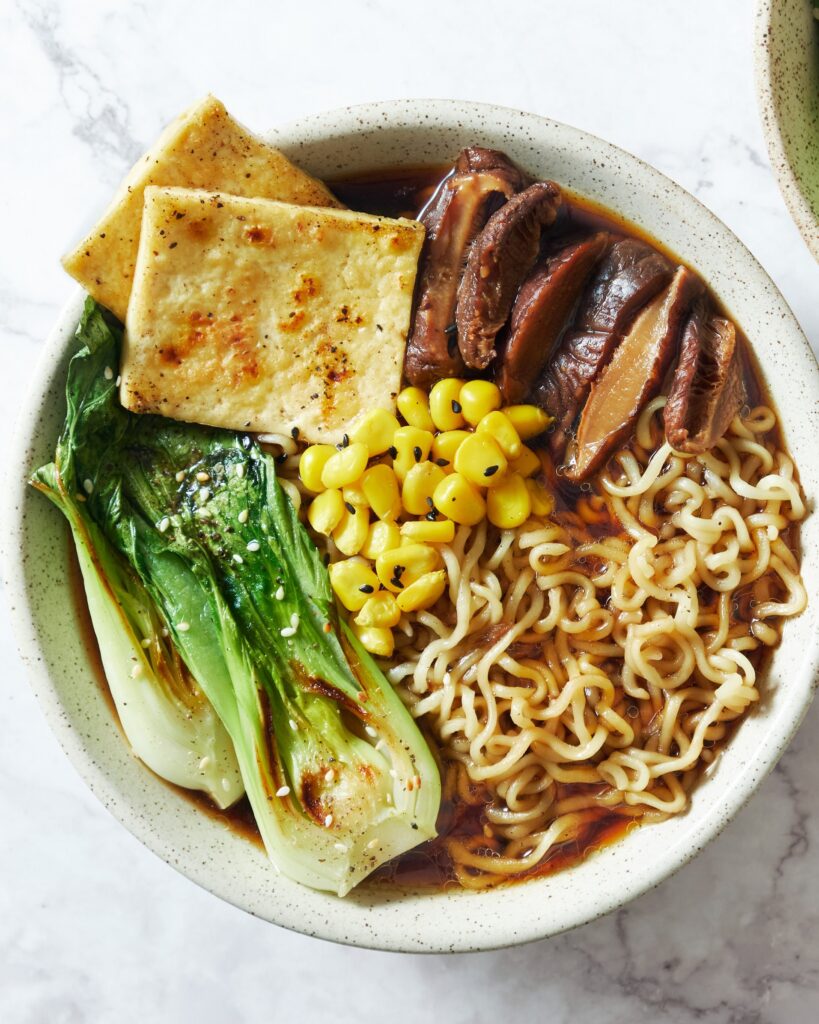
Sponsored By

This is an unsponsored, ad-free recipe. If you’d like to support my work, please consider:
Thank you! 💜 😊
Shoyu Ramen, traditionally made with a chicken or pork-based broth, can be transformed into a satisfying vegan dish without compromising its rich umami flavor. This version uses kombu (dried kelp) and dried shiitake mushrooms as the base, complemented by aromatics like ginger, garlic, and onion. The broth gets its characteristic dark color and depth from soy sauce, while a touch of rice vinegar adds brightness.
The dish comes together with classic ramen toppings adapted for a plant-based diet. Pan-fried tofu provides protein and a pleasant chewy texture, while lightly seared bok choy adds a fresh, slightly bitter note that cuts through the rich broth. Sweet corn kernels bring small bursts of natural sweetness to each spoonful.
This recipe takes about 45 minutes to prepare, with most of that time dedicated to simmering the broth to extract maximum flavor from the mushrooms and kombu. While restaurant-style ramen can be intimidating to make at home, this version simplifies the process by using readily available ingredients and basic cooking techniques.
The final bowl brings together the hot broth, chewy noodles, and carefully prepared toppings, finished with a sprinkle of toasted sesame seeds. Each component contributes its own texture and flavor, creating a balanced meal that's both nourishing and deeply satisfying.
For the Shoyu Soup:
For the Pan-fried Tofu & Bok Choy:
For Assembly:
Step A: Prepare Shoyu Soup
Step B: Prepare Pan-fried Components
Step C: Prepare Noodles and Corn
Step D: Finish Soup
Step E: Final Assembly
Absolutely! Feel free to add vegetables like carrots, spinach, or bok choy directly into the broth for extra flavor and nutrition. Just make sure to adjust the simmering time based on the vegetables you use.
If you don’t have sesame oil, you can substitute with olive oil or vegetable oil. However, sesame oil adds a unique flavor that enhances the broth’s depth.
If you don’t have rice vinegar, you can use apple cider vinegar as a substitute. The flavor will be slightly different but still tangy and mild.
Yes, you can use tamari or coconut aminos as gluten-free alternatives to traditional soy sauce. Keep in mind that tamari may have a richer flavor, and coconut aminos are slightly sweeter.
Yes, you can adjust the sweetness by adding more or less sugar, or substituting with maple syrup or agave for a different flavor profile.
Kombu adds a natural umami flavor to the broth, but if you can’t find it, you can substitute with a little extra soy sauce and a small pinch of seaweed flakes (like wakame) to mimic the oceanic taste.
Try these delicious ideas:
Great0%
Good0%
Decent0%
Bad0%
Terrible0%
No similar recipes found.
Stay tuned.
Subscribe to my newsletter
One newsletter a week. No spam.
This form is protected by reCAPTCHA.
Google Privacy Policy and Terms of Service apply.